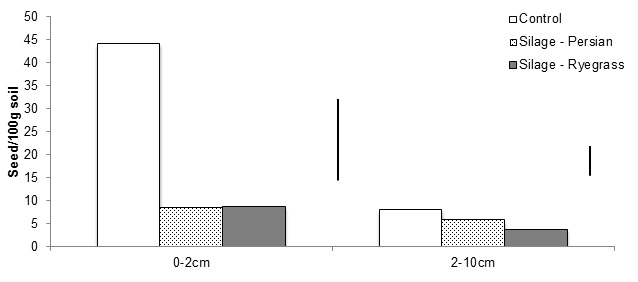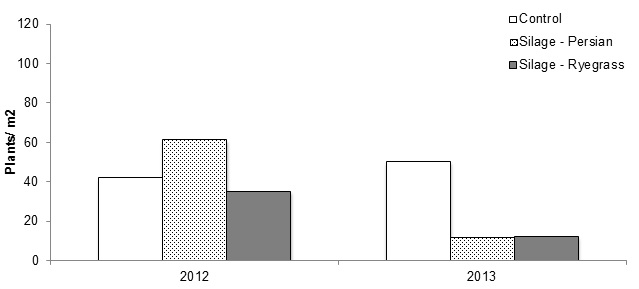Managing wild radish (Raphanus raphanistrum) in grain crops - preventing seed set to deplete the seed bank
Author: Emma Henne and Peter Sale | Date: 05 Feb 2014
Take home messages
- A modified flotation method was developed to extract wild radish seed and measure radish seed numbers in topsoil samples.
- In a severely wild radish infested paddock in 2012, preventing wild radish seed set for one year using silage crops, markedly reduced seed bank numbers by over 80%. Radish emergence in the following crop in 2013 was reduced by 60-80% by the previous silage crop.
- Most farmers believe that depleting the wild radish seed bank is just too time consuming and uneconomical; some farmers however have been able to successfully deplete the radish seed bank.
Background
Wild radish, Raphanus raphanistrum L. is one of the most challenging crop weeds in the Southern Australian grain belt (Walsh and Powles 2009). Its persistence as a weed is attributed to; its ability to germinate at any time through the year, to prolonged seed longevity in the soil, to the large number of seed that can be produced by the wild radish plants, and to its competitiveness due to rapid seedling establishment and fast growth rate (Cheam 1986; Walsh et al. 2007; Cheam et al. 2008). Cropping farms in Western Australia and more recently in South Australia and Victoria are now becoming increasingly infested with wild radish (Nugent 1999).
With the introduction and development of no-till systems, herbicides have been the only way to control this weed (Walsh et al. 2007; Walsh and Powles 2007). However the use of herbicides to control wild radish cannot generally achieve a complete weed kill and so they cannot completely prevent seed set by surviving weeds. Unfortunately the repeated use of herbicides has led to the development of herbicide resistant radish populations, particularly in Western Australia, where it has been difficult to control wild radish in the lupin phase of the rotation. I have seen paddocks in the Geraldton district in WA that are badly infested with wild radish that is resistant to practically every herbicide option. This situation is very serious.
Campbell (2013) and Walsh et al. (2009) suggest that the only way to control resistant wild radish populations, is the use of an integrated weed management (IWM) program based around seed set control. Methods to stop seed set include the use of silage or hay crops, and green or brown-manured crops. These practices, in an IWM program, can provide some economic return from the crop, either in terms of dollars or from soil health benefits. The idea of such a program is to mix both physical and chemical control methods, for example, using a pre-emergent spray followed by cutting the crop for hay (Ball 1992). The practices have generally not been adopted due to the expense involved in purchasing herbicides, the time required for the spray applications, and the cost of hay or silage making with perhaps uncertain markets for the products.
My Honour’s research in 2013 investigated the proposition that wild radish could/should be managed by completely preventing seed set (100% control), thereby depleting the seed bank in the soil over time. My first objective was to measure how just a single year of seed set prevention with silage making would affect seed bank numbers, in a severely infested paddock. This required a technique to extract wild radish seed from the top soil layers, and then measure seed bank numbers in the field after making silage in the spring, to stop seed set. An additional objective was to survey the opinions of farmers and advisers on the feasibility of complete seed set control over time to deplete the seed bank.
Experimental approach
Measurements were undertaken at a field trial in Inverleigh in south west Victoria that was severely infested with wild radish. This was part of a larger wild radish control experiment conducted by Southern Farming Systems. Plots were selected that had high wild radish populations in the early winter in 2012, and were then sown to either persian clover or annual ryegrass, for silage making in the spring of 2012. Wild radish seedling emergence was also counted in the early winter of 2013. Topsoil samples were collected from these plots and from control plots, in July 2013. A method for extracting wild radish seed from soil samples was developed by placing the soil in a solution that allows the seed and light debris to float. This flotation technique was used with the 0-2 cm and 2-10 cm deep soil samples collected from the trial plots, to extract and count the wild radish seed in the seed bank in the topsoil samples.
Farmers and advisers from a range of cropping backgrounds across the southern Australian wheatbelt were surveyed in relation to wild radish infestation on their farms. Advisers were a target for these surveys as they advise farmers on weed control strategies on the farms. Farmers and advisers were approached on field trips to Western Australia, at field days run by agricultural organisations and on farms. The main focus of the survey was on how wild radish seed set might be prevented in cropping paddocks, and whether this would be both a feasible and an economic strategy for managing wild radish infestations.
Results and discussion
Growing a silage crop at Inverleigh successfully prevented seed set in 2012. This cessation of seed set for just one season markedly reduced wild radish infestation in the paddock. The annual ryegrass and persian clover silage treatments significantly reduced seed bank numbers by more than 80% in the top soil (0-2 cm depth) and by 30 – 55% in the deeper 2-10 cm soil (Figure 1). Also there were fewer radish emerging in 2013 (Figure 2) in the silage plots compared to the control plots.

Figure 1. Wild radish seed bank numbers (seed/100 g soil) in July 2013 after seed set had been prevented by growing a Persian clover or ryegrass crop for silage in the winter/spring of 2013. Seed were extracted from soil collected at depths of 0-2 and 2-10 cm. Vertical bars represent LSD (p=0.05).

Figure 2. The emergence of wild radish seedlings (plants/m2) in the early winter in 2012, and then in 2013 following a Persian clover or ryegrass silage crop in 2012. Vertical bars represent LSD (p = 0.05).
The silage strategy produced high yields of ryegrass or clover biomass that could be rapidly ensiled to make very high quality silage, as well as stopping seed set. It is likely that such silage, in the Victorian high rainfall zone, could be sold to farmers, particularly dairy farmers located within a 50-100km radius from the cropping paddock. The equivalent dry matter yields were 3.6 tonne/ha for persian clover and 5 tonne/ha for annual ryegrass silage at 45% moisture (C. Celestina, personal communication). The sale of this high quality silage would generate a useful cash return for the farm while achieving 100% seed set control (Stanton et al. 2012). Follow up herbicide management or heavy grazing after the silage is harvested would be required to prevent subsequent wild radish emergence if summer rainfall events occurred (Nugent 1999; Blackshaw et al. 2002; McGillion and Storrie 2006). It would be important for farmers to seek a silage market before using this strategy instead of other less expensive radish control tactics.
Grower and adviser attitudes to complete seed bank depletion
There were a range of responses from farmers and advisers towards the proposition that 100% seed set control of wild radish to deplete the seed bank could or should be used. The advisers that were approached in Victoria were focused on the use of herbicide, as herbicide-susceptible wild radish populations were still widespread. Some advisers however considered that 100% seed set control should be the ideal that their clients aim for. Advisers who I approached in Western Australia, who had to deal with widespread herbicide-resistant radish populations were more concerned about relying on herbicide control. They realize that a ‘stacked-herbicide-resistant’ population cannot be controlled with herbicides any more, and they are running out of herbicide options. This has led to them advising their clients to consider physical approaches such as moldboard ploughing or burning narrow windrows after harvest. A number of farmers, who were approached, were very pessimistic about the idea of 100% seed set control of wild radish in their crops; they believed it was uneconomical even if it were possible. However some were trying IWM strategies such as chaff carts and livestock grazing within their rotations with positive results.
The future for stopping 100% of wild radish seed set, and depleting the seed bank, will depend on positive attitudes and real commitment from farmers and advisers. While most farmers believe that this strategy is not possible, nor economical, a few farmers and most of the participating advisers had more positive attitudes to stopping seed set and depleting the seed bank. Their attitudes resulted from successful practices used for controlling herbicide-resistant wild radish populations. These experiences need to be publicized as successful case studies, in workshops and seminars, so that all grain producers can see that it is possible to really get on top of wild radish in their paddocks.
Acknowledgements
I would like to thank Peter Sale for all his contributions and continual support during my research and also throughout my Agricultural Science studies at La Trobe University. I would also like to thank Southern Farming Systems, in particular Corinne Celestina and Annieka Paridaen for their help with the field studies. The time given by all the farmers and advisers who I contacted, particularly Greg Toomey, Grant Thompson and Bill Campbell, and their general interest and advice in the project was much appreciated.
References
Ball DA (1992) Weed seedbank response to tillage, herbicides, and crop rotation sequence. Weed Science 40, 654-659.
Blackshaw RE, Lemerle D, Young KR (2002) Influence of wild radish on yield and quality of canola. Weed Science 50, 344-349.
Campbell B (2013) 'Understanding and managing proposed different development stages of herbicide resistance in wild radish (raphanus raphanistrum), GRDC Crop updates.' SA, Vic and WA. pp 49-58.
Cheam A (1986) Seed production and seed dormancy in wild radish (Raphanus raphanistrum l.) and some possibilities for improving control. Weed Research 26, 405-414.
Cheam AH, Storrie A, Koetz E, Holding D, Bowcher A, Barker J (2008) 'Managing wild radish and other brassicaceous weeds in Australian cropping systems.' (CRC for Australian Weed Management)
McGillion T, Storrie A (2006) 'Integrated weed management in Australian cropping systems: A training resource for farm advisors.' (Cooperative Research Centre for Australian Weed Management: Adelaide, South Australia)
Nugent T (1999) 'Managing wild radish (Raphanus raphanistrum l.).' (CRC for Weed Management Systems and the Grains Research and Development Corporation)
Walsh MJ, Owen MJ, Powles SB (2007) Frequency and distribution of herbicide resistance in raphanus raphanistrum populations randomly collected across the Western Australian wheatbelt. Weed Research 47, 542-550.
Walsh MJ, Powles SB (2007) Management strategies for herbicide-resistant weed populations in Australian dryland crop production systems. Weed Technology 21, 332-338.
Walsh MJ, Powles SB (2009) Impact of crop-topping and swathing on the viable seed production of wild radish (raphanus raphanistrum). Crop and Pasture Science 60, 667-674.
Contact details
Emma Henne
Department of Agricultural Sciences LaTrobe University, Melbourne
Ph: 0424 930 317
Email: emma.henne@hotmail.com
Was this page helpful?
YOUR FEEDBACK
